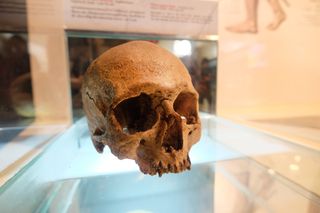Early Humans Probably Didn't Evolve from a Single Population in Africa

Homo sapiens are incredibly diverse — we live in wildly different societies, follow different rules and love and fear different gods.
Despite that awesome diversity, mounting evidence suggests the first humans were even more different from one another than we are today.
In a new commentary published online on Wednesday (July 11) in the journal Trends in Ecology & Evolution, an interdisciplinary group that includes geneticists, bioanthropologists, and archaeologists argues that we didn't evolve from a single population in a single region of Africa, but rather from separate populations across Africa that fully mixed only much later. [Image Gallery: Our Closest Human Ancestor]
Evidence is showing that "human ancestors were already scattered across Africa," said Eleanor Scerri, a research fellow at Oxford University and lead author of the paper. And "the combination of behavioral and physical and cognitive features that define us today started to slowly emerge within the occasional mixing of these different ancestral groups," she added. (Scerri is also a research associate for the Max Planck Institute for the Science of Human History in Germany.)
To draw this conclusion, Scerri and her team not only looked at the available fossil evidence, but also at genetic, archaeological and paleoenvironmental data.
About half a million years ago, Neanderthals and Homo sapiens began to diverge from a common ancestor, according to Scerri. But only around 300,000 years ago did early people actually begin to have features that made them look like humans, she said.
Even then, "all the fossils between 300,000 years ago and about 100,000 years ago don't really look like anyone living today," Scerri told Live Science. The features that define us today, such as a small face, prominent chins, a globular skull and small teeth, were indeed present back then, but not all in a single person, she said.
"These features tend to be distributed across the early fossils in different combinations with different, what we call, more primitive or archaic features that we don't see in anyone living today," Scerri said. So, someone in Eastern Africa may have had the small teeth, whereas someone in southern Africa may have had a globular skull while the rest of their features remained primitive.
And these groups remained separate for a long time, because the dense forests and deserts in Africa served as formidable barriers, according to Scerri. But with the occasional mixing of different groups, between 100,000 and 40,000 years ago, fossils that combine all the modern features in a single individual begin to appear, Scerri said.
"Which means, of course, that evolution probably progressed at a different speed and tempo in different regions of Africa as different groups came into contact with each other at different times," Scerri said. Though it's not clear when most humans on the planet had these modern features, by about 12,000 years ago, when hunting and gathering gradually shifted to agriculture, archaic features such as an elongated head and large robust faces had all but disappeared in humans, Scerri said. (In any case, these archaic features, it should be noted, don't correspond to how "culturally backward" a culture was, Scerri added.)
Ancient tools also buttress this theory, Scerri said.
For about two million years, hominins made "somewhat crude" handheld tools like hand axes or large cutting tools, Scerri said. About 300,000 years ago, "there's really an explosion of different and specialized stone tool forms," she added. These tools, that often used different bindings, different glues, and different designs, took hold in different places across the continent.
"I think there are just a handful of people who are really, really strong proponents of the idea that modern people came from one very restricted region," said Rebecca Ackermann, a biological anthropologist at the University of Cape Town in South Africa who was not an author of the commentary. So "I don't think the conclusions themselves were particularly novel." [Top 10 Mysteries of the First Humans]
However, "it's good to see [these ideas] being considered in kind of a holistic way," she added.
"Who was arguing the contrary?" said Jon Marks, a professor of anthropology at University of North Carolina, Charlotte, who was also not part of the study. Though the findings didn't come as a shock to Marks, he thinks they point to an important problem in the field — we might be using the wrong metaphors to describe evolution, namely, Darwin's branching tree.
"What we're seeing is a tree is not necessarily the most appropriate metaphor to apply to recent human ancestry," Marks told Live Science. The more appropriate metaphors would be something that branches and then comes back together, rather than branches on a tree, he said.
These could include the roots of a tree, braided streams or capillary systems, he said.
Originally published on Live Science.
Live Science newsletter
Stay up to date on the latest science news by signing up for our Essentials newsletter.

Yasemin is a staff writer at Live Science, covering health, neuroscience and biology. Her work has appeared in Scientific American, Science and the San Jose Mercury News. She has a bachelor's degree in biomedical engineering from the University of Connecticut and a graduate certificate in science communication from the University of California, Santa Cruz.
Most Popular

By Harry Baker

By Harry Baker

By Tom Metcalfe

By Ben Turner